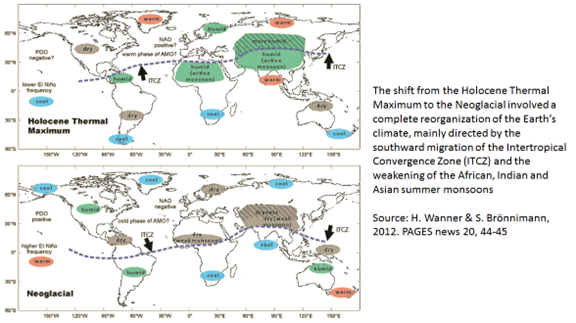With increasing anthropomorphization of “climate”, few know that just 5,000 years ago, the massive desert extending from North Africa, through the Middle East and across Asia to the Gobi Desert in China was lush and a highly hydrated landscape. Even fewer know that the average temperature of the Earth in this era was significantly warmer than today.
This epoch is known as the Holocene Climate Optimum (HCO) or Holocene Thermal Maximum (HTM).
To kick-start this literature review, I include Figure 1, which shows the change in summer temperature and precipitation across China since the last glacial maximum (LGM) 20,000 years ago and up until present. I have added text to mark the LGM, HTM, and present.
According to Feng Shi et al, this 20,000-year paleo-record is said to be primarily a function of changing summer sunshine (aka insolation) intensity as the obliquity, or tilt, of the Earth changes as part of the climate forcing called Milankovitch Cycles. According to the Milankovitch Cycle hypothesis, the tilt of the Earth toward the Sun peaked at the HTM, with the Northern Hemisphere receiving the brunt of this increased insolation.
Since the HTM, summer insolation, temperatures, and precipitation across China have been gradually declining up until present.
This transition from a thermal or humidity maximum to a condition of declining humidity is commonly called a neoglacial phase of an interglacial period.
Figure 2 shows a typical representation of the complete reorganization of the global climate system from the HTM to the neoglacial. Comparing Figures 1 and 2 shows that the summer Monsoon over Asia declined after the HTM, as it did across India, Middle East, and Africa.

Figure 2 – Illustration showing the planetary reorganization of the Intertropical Convergence Zone (ITCZ) as the Earth transitions from the Holocene Thermal Maximum to the current neoglacial phase.
Figure 2 highlights that the polar latitudes of the Northern Hemisphere were warmer than the polar latitudes of the Southern Hemisphere during the HTM, and that this temperature gradient began to reverse as the neoglacial phase advanced.
Figure 2 also shows that the Intertropical Convergence Zone (ITCZ), which in atmospheric physics marks the latitude of maximum precipitation, began to migrate toward the Southern Hemisphere after the HTM. As it did, broad-scale desertification developed from Africa to Asia.
The dynamics and migration of the ITCZ within the Holocene Interglacial is of fundamental importance in understanding both paleoclimatology and modern climate trends.
Figure 3 shows the ITCZ migration over the past 12,000 years, together with three different y-axis to aid in understanding the underlying evolution of global climate as the Earth`s obliquity changed from the LGM to present. Note that I have added text to mark the HTM, Roman warm period (RWP), the Medieval warm period (MWP), the Dark Age period (DAP), and the little ice age (LIA).
As well, I have added dashed vertical lines and text to highlight accepted geological classifications of the Holocene Subepochs known as the Greenlandian (glacial termination), Northgrippian (HTM) and Meghalayan (neoglacial).
Tapio Schneider et al[1]made use of extensive geochemical proxies for temperature and precipitation to show that the ITCZ advances toward (away from) whichever hemisphere is warming (cooling) faster than the other, and that this differential warming (cooling) brings greater (decreased) summer precipitation.
Thus, Figure 3 shows the Northern Hemisphere was warmer and wetter during the HTM, while the Southern Hemisphere was cooler and drier as the Earth advanced past the HTM and into the current neoglacial phase of the Holocene Interglacial.
The 4200 ka Global Aridification Event[2]marks the beginning of the current Meghalayan sub-epoch or neoglacial, and is generally accepted to represent a two-century-long global drought that brought an end to the Old Egyptian Kingdom, the Akkadian Kingdom in Mesopotamia, the Liangzhu culture in the lower Yangtze River area, and the Indus Valley civilization.
The 4200 ka Global Aridification Event gave rise to the present-day desertification extending from North Africa to the Gobi Desert and is viewed as the most severe climatic event of the Holocene.

Figure 3 – Migration of the Intertropical Convergence Zone (ITCZ) within the Holocene Interglacial.
The migration of the ITCZ over the Holocene has markedly affected Africa. To illustrate the broad base of paleo-data for this region, I include Figures 4a and 4b. Figure 4a demonstrates the ecosystem evolution from the LGM to the current warm period (CWP), and Figure 4b provides more detail on the expansiveness of forests and bodies of water during the HTM.
Note the near absence of desertification during the HTM and the similarity in desertification extent between the LGM and the CWP. Both Figure 4a[3]and 4b show how large Lake Chad was during the HTM. Numerous studies have shown that Lake Chad would have been larger than today’s Caspian Sea (370,000 km2), or roughly the size of Germany[4].
During the CWP of the 20th century, Lake Chad has varied in size from 2,000 to 5,000 km2.
This shows that the transition from the HTM to the current neoglacial phase has not only pulled the ITCZ southward over Africa, but has on a continental basis, resulted in a significant reduction in precipitation overall as seen by the contraction of the tropical rainforest climate zone.

Figure 4a – Landscape ecosystem type coverage and evolution across Africa over the Holocene Period.

Figure 4b – Artist impression of Africa during the Holocene Thermal Maximum (HTM).
The next and final climate zone that I will discuss is the North Atlantic region.
Figure 5 shows the reconstruction of North Atlantic summer sea surface temperatures (SST) by Jiang H. et al, who made use of standardized geochemical analysis of sedimentary samples, from 9,500 and up until 1930 (1930 is defined as the present) to show the neoglacial decline in SST since the HCO. Again, I have added the HCO, RWP, and MWP text to mark known periods in which the North Atlantic climate zone was known to experience rapid warming excursions.

Figure 5 – Proxy reconstruction of summer sea surface temperatures over the North Atlantic during the neoglacial phase of the Holocene.
Note that the peak HCO SST in Figure 5 coincides with the most northerly extent of the ITCZ shown earlier in Figure 3. This illustrates that higher temperatures in the Northern Hemisphere act to draw the ITCZ northward.

Figure 6a – Reconstruction of proxy summer air temperature change in Northwest Greenland over neoglacial phase of the Holocene.
As part of the North Atlantic climate regime, Greenland`s surface air temperatures began to go into a long-term decline, and glacial ice started to accumulate as the HCO gave way to the neoglacial phase.
These trends are shown in Figures 6a and 6b.
Figure 6a shows the proxy summer air temperature changes from northwestern Greenland over the past 8,000 years and up until the CWP (0 ka) and Figure 6b is a cross-section of glacial ice across Greenland measured using ice-penetrating radar[5].

Figure 6b – Ice-penetrating radar cross-section of Greenland icefield.
Figure 6b shows that approximately half of Greenland`s glacial mass melted between the LGM and the HCO (top of blue) and that as the ITCZ peaked and began to migrate southward, summer air temperatures went into a long-term decline and Holocene ice began to form (green volume).
The Holocene neoglacial ice (green) versus LGM ice (blue) is shown overlaid on Eemian ice (red) in Figure 6b. Note that the Eemian period was the previous interglacial that occurred approximately 120,000 years ago and its thermal maximum was significantly warmer than the HCO. Thus, we see that there is a smaller residual volume of Eemian ice present at the base of Greenland`s icefield versus LGM ice.
Having covered regional examples of the LGM to neoglacial transition from Asia, Africa, and the North Atlantic, I conclude this review by examining two studies that cover at higher temporal resolution the last 2,000 years of the Holocene neoglacial phase.
In Figure 7, I have plotted both Craig Loehle`s global average[6]and Fredrik Ljungqvist et al[7]extra-tropical Northern Hemisphere air temperature anomaly time series over the past 2,000 years. The input data for these anomaly time series comes from a couple a dozen regional paleo-climate studies that used a variety of ice-core, tree-ring and other geochemical proxies for changes in air temperature.

Figure 7 – Global and extra-tropical Northern Hemisphere air temperature anomaly reconstructions over the past 2,000 years.
Note the remarkable temporal coherence in coinciding peaks during the MWP and CWP, together with minimum air temperatures in the little ice age (LIA). This coherence proves that changes in temperature during these periods were truly global in extent.
On the other hand, Fredrik Ljungqvist et al air temperature anomaly shows both a strong RWP peak and a Dark Age period (DAP) minimum that is only weakly present in Craig Loehle`s global average. This suggests that the changes in air temperature associated with the RWP and DAP were more apparent in the extra-tropical Northern Hemisphere than in southern latitudes.
The lack of a globally coherent change in air temperature around the RWP and DAP, versus the excellent coherence at the MWP and LIA, does not mean the former events did not have a global impact on climate.
In Figure 3, we observe that the ITCZ advanced northward during the RWP and the MWP, and rapidly reversed course following each warming period as the Earth moved into the DAP and LIA cooling phases. This confirms the planetary scale of these quasi-periodic planetary scale atmospheric perturbations, and demonstrates that climate change is far more than simply a change in temperature.

Figure 8 – Javier Vinos representation of an interglacial neoglacial phase as a period of extreme climate instability prior to a glacial maximum.
This literature review ends with a generalization of an interglacial to neoglacial transition, as shown in Figure 9. In Javier Vinos`s 2022 book Climate of the Past, Present and Future[8], he highlights that neoglacials are defined by both glacial inception and by increasing climatic variability, as the Earth advances deeper into a glacial maximum state. This increasing variability is conveyed by the growing oscillation amplitude as the neoglacial trend continues toward a glacial maximum.
I have added text to Javier`s representation to show the onset of a neoglacial, as well as interstadials and stadials to his peaks and troughs, respectively. In classical paleoclimatology, stadials are defined as rapid cooling events, and interstadials as rapid warming events, where both can last for as long as a few centuries before returning to the long-term neoglacial trend.
I propose that the DAP and LIA are examples of stadials, and the RWP and MWP are interstadials. Furthermore, the 1,000-year separation in peak temperatures between the RWP, MWP, and the CWP (Figure 7), suggests the latter, too, may simply be just another neoglacial interstadial.
Inclusion: this review demonstrates that on climatic time scales, a warmer climate is a more humid climate, given the hydrological cycle likewise increases in its rate of evaporation and precipitation as surface temperatures increase. Conversely, desertification and glacial inception increase as the climate cools.
Reference:
[1] Migrations and dynamics of the intertropical convergence zone, Schneider, Bischoff, Haug, Macmillan Publishers Ltd.
[2] 2-kiloyear event – Wikipedia
[3] 4 Changes of the African bioclimatic regions over the last 20.000. – Download Scientific Diagram (researchgate.net)
[4] 5,000 years ago, the Sahara and Arabia were warmer, wetter with wild flora and fauna, Frank Ewald Lanser, Klimarealisme
[5] NASA Data Peers into Greenland’s Ice Sheet – NASA
[6] A 2000-Year Global Temperature Reconstruction Based on Non-Treering Proxies, Craig Loehle, Energy & Environment, Volume 18, No. 7+8, 2007
[7] A New Reconstruction of Temperature Variability in the Extratropical Northern Hemisphere During the Last Two Millenia, Fredrik Charpentier Ljungqvist, Swedish Society for Anthropology and Geography
[8] (PDF) Climate of the Past, Present and Future. A scientific debate, 2nd ed., Critical Science Press
(Dr. Joseph Fournier – BIG Media Ltd., 2024)


